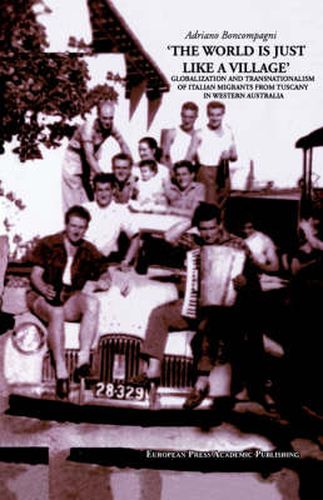Readings Newsletter
Become a Readings Member to make your shopping experience even easier.
Sign in or sign up for free!
You’re not far away from qualifying for FREE standard shipping within Australia
You’ve qualified for FREE standard shipping within Australia
The cart is loading…






This title is printed to order. This book may have been self-published. If so, we cannot guarantee the quality of the content. In the main most books will have gone through the editing process however some may not. We therefore suggest that you be aware of this before ordering this book. If in doubt check either the author or publisher’s details as we are unable to accept any returns unless they are faulty. Please contact us if you have any questions.
An analysis of the historical and socio-economic factors of Tuscany, which have been conducive to overseas migration. Boncompagni studies the patterns of geographical and occupational distribution of Tuscan migrants in Western Australia, as well as their social adjustment to the host country. The World is Just Like a Village takes into account the century-long tradition of internal and overseas migration of Central Italian people, which permitted forms of cosmopolitanism and allowed them to feel comfortable and secure whatever was their destination as migrants. Since the turn of the 20th century, and more markedly from the 1920s, migrants from Tuscany chose Australia as one of their overseas destinations, often joining friends and relatives who had previously acted as pioneers . The sense of security that a little Tuscany overseas could offer, allowed many to transplant the century-long tradition of temporary migration of the Tuscan Apennine communities into the Australian working and residential environment. The strength of the historical legacy of migrants from Tuscany in Western Australia in particular is shown by the specific residential and occupational mobility among Tuscan migrants, which has prevailed over Australia’s major migration policies of the 20th century. The relationship between the historical, economic and social background of migrants and their adjustment to the Australian residential, occupational and social milieu is concluded to be pivotal to an understanding of the specific migratory patterns of this Italian regional group, and as a possible interdisciplinary tool of analysis of other ethnic groups within multicultural Australia. Boncompagni has devoted five years of research-combining through public archives, published literature, files of private organizations, and direct interviews to recapturing the creation of a community. He describes such factors as regional origins, migration patterns, population growth and the formation of communal institutions.
$9.00 standard shipping within Australia
FREE standard shipping within Australia for orders over $100.00
Express & International shipping calculated at checkout
This title is printed to order. This book may have been self-published. If so, we cannot guarantee the quality of the content. In the main most books will have gone through the editing process however some may not. We therefore suggest that you be aware of this before ordering this book. If in doubt check either the author or publisher’s details as we are unable to accept any returns unless they are faulty. Please contact us if you have any questions.
An analysis of the historical and socio-economic factors of Tuscany, which have been conducive to overseas migration. Boncompagni studies the patterns of geographical and occupational distribution of Tuscan migrants in Western Australia, as well as their social adjustment to the host country. The World is Just Like a Village takes into account the century-long tradition of internal and overseas migration of Central Italian people, which permitted forms of cosmopolitanism and allowed them to feel comfortable and secure whatever was their destination as migrants. Since the turn of the 20th century, and more markedly from the 1920s, migrants from Tuscany chose Australia as one of their overseas destinations, often joining friends and relatives who had previously acted as pioneers . The sense of security that a little Tuscany overseas could offer, allowed many to transplant the century-long tradition of temporary migration of the Tuscan Apennine communities into the Australian working and residential environment. The strength of the historical legacy of migrants from Tuscany in Western Australia in particular is shown by the specific residential and occupational mobility among Tuscan migrants, which has prevailed over Australia’s major migration policies of the 20th century. The relationship between the historical, economic and social background of migrants and their adjustment to the Australian residential, occupational and social milieu is concluded to be pivotal to an understanding of the specific migratory patterns of this Italian regional group, and as a possible interdisciplinary tool of analysis of other ethnic groups within multicultural Australia. Boncompagni has devoted five years of research-combining through public archives, published literature, files of private organizations, and direct interviews to recapturing the creation of a community. He describes such factors as regional origins, migration patterns, population growth and the formation of communal institutions.